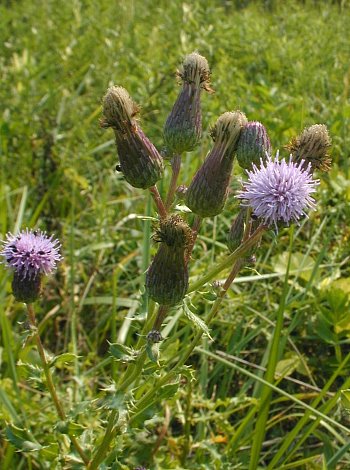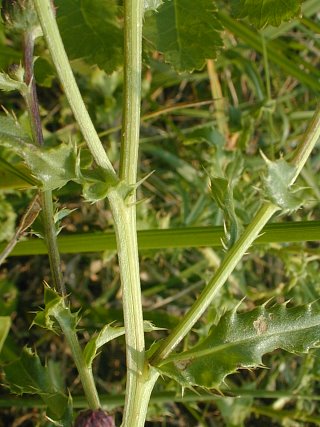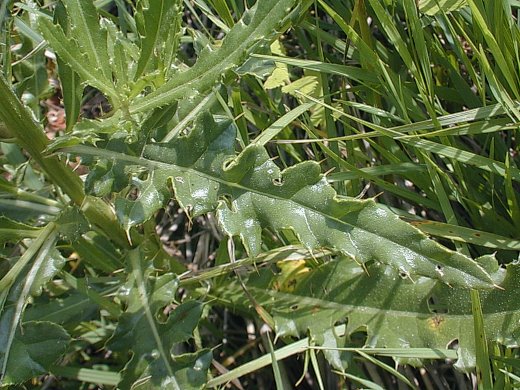Description: This herbaceous perennial plant is 1-3' tall, branching occasionally in the upper half. The light green stems are slightly ridged. The alternate leaves are up to 8" long and 1" across, but usually about 3-4" long and 2/3" (17 mm.) across. They are lanceolate or elliptic in shape, pinnatifid and/or dentate along their margins, and either sessile or clasping the stems. Some of the lower leaves may taper gradually to a petiole-like base. The leaf margins have numerous pale yellow thorns, and tend to be rather crinkly. The stems and leaf undersides can be hairless or somewhat hairy, depending on the variety. The leaf uppersides are hairless.

The upper stems
terminate into one or
more flowerheads. Each flowerhead is about ½–¾"
across, consisting of numerous disk florets and no ray florets. The
corollas of disk florets are pale pink or lavender. At the base of each
flowerhead, there are overlapping green to purple bracts (phyllaries)
in several series; these bracts are appressed together. The bracts have
sharp pointed tips. The blooming period usually occurs from early to
mid-summer,
although plants may bloom later in the year if their growth is
disrupted by disturbance. The flowerheads have a sweet fragrance.
Canada Thistle is occasionally dioecious, with male and female
flowerheads
occurring on separate plants, otherwise they are perfect. The brown
achenes of female florets are
slender and slightly ridged at their apices, where they have tufts of
light brown
hair. These achenes are distributed by the wind. The root system is
rhizomatous. Canada Thistle often forms clonal colonies as a result of
these rhizomes; these colonies can extend several feet across.
Cultivation:
The preference is full sun, moist to mesic conditions,
and a fertile soil consisting of clay-loam. Canada Thistle can grow in
drier sites with less fertile
soil, but the resulting plants will be stunted. The upper leaves often
turn yellow or pale green in response to severe summer heat and
drought, and growth will stop. Eradication
of this plant is difficult because it can regenerate from small pieces
of the rhizomes. The most effective control method involves the
application of broadleaf herbicides.
Range & Habitat:
The non-native Canada Thistle is a common plant that occurs primarily
in central and
northern Illinois (see Distribution
Map). It is apparently less common or absent from many areas
of southern Illinois, although it could be spreading southward.
Contrary to the common name, this plant is originally from Eurasia,
although it may have entered the United States after being introduced
to Canada.
Typical habitats include cropland, abandoned fields, areas along roads
and railroads, vacant lots, weedy meadows, and degraded prairies. This
plant can invade lawns that are not mowed regularly, and it is
aggressive enough to invade many natural habitats.
Faunal Associations:
The flowers of Canada Thistle attract a wide variety of insects,
including long-tongued bees, short-tongued bees, Sphecid wasps, Vespid
wasps, miscellaneous flies, butterflies, skippers, and beetles. Both
nectar and pollen are available as floral rewards. The caterpillars of
the butterfly Vanessa cardui (Painted Lady) feed
on the foliage, as do the caterpillars of many moth species (see Moth
Table). Others insects that feed on the foliage, roots,
seeds, and other parts of Canada Thistle include leaf beetles, larvae of weevils,
stink bugs, aphids, treehoppers, larvae of fruit flies, and
grasshoppers; the Insect Table lists
many of these species. The seeds
of Canada Thistle and other thistles are a source of food to
some songbirds, including the Eastern Goldfinch, Pine
Siskin, Slate-Colored Junco, Indigo Bunting, and Clay-Colored Sparrow.
Because of the thorny foliage, mammalian herbivores usually avoid
eating this plant, except when little else is available. If the spiny
foliage
is eaten, they can have problems with irritation of their
mouthparts and digestive tract.

Comments: For many gardeners, farmers, and ecologists in the Northeast and Midwest, Canada Thistle is one of the most feared species of thistles, largely because it forms dense colonies that can be difficult to eradicate. Unlike most thistles in Illinois, it is a rhizomatous perennial, rather than a biennial with a taproot. Canada Thistle can be distinguished from other thistles by considering the following characteristics: 1) it tends to bloom earlier in the year, 2) it is usually less tall and more slender-stalked, and 3) its flowerheads are smaller in size and the corollas of their florets are more pale-colored. Several varieties of Canada Thistle have been described, although most of them are not recognized in Illinois. Walking through a colony of Canada Thistle is an unpleasant and scratchy experience, but it is less formidably armed than Cirsium vulgaris (Bull Thistle). Another common name of Cirsium arvense is Field Thistle.